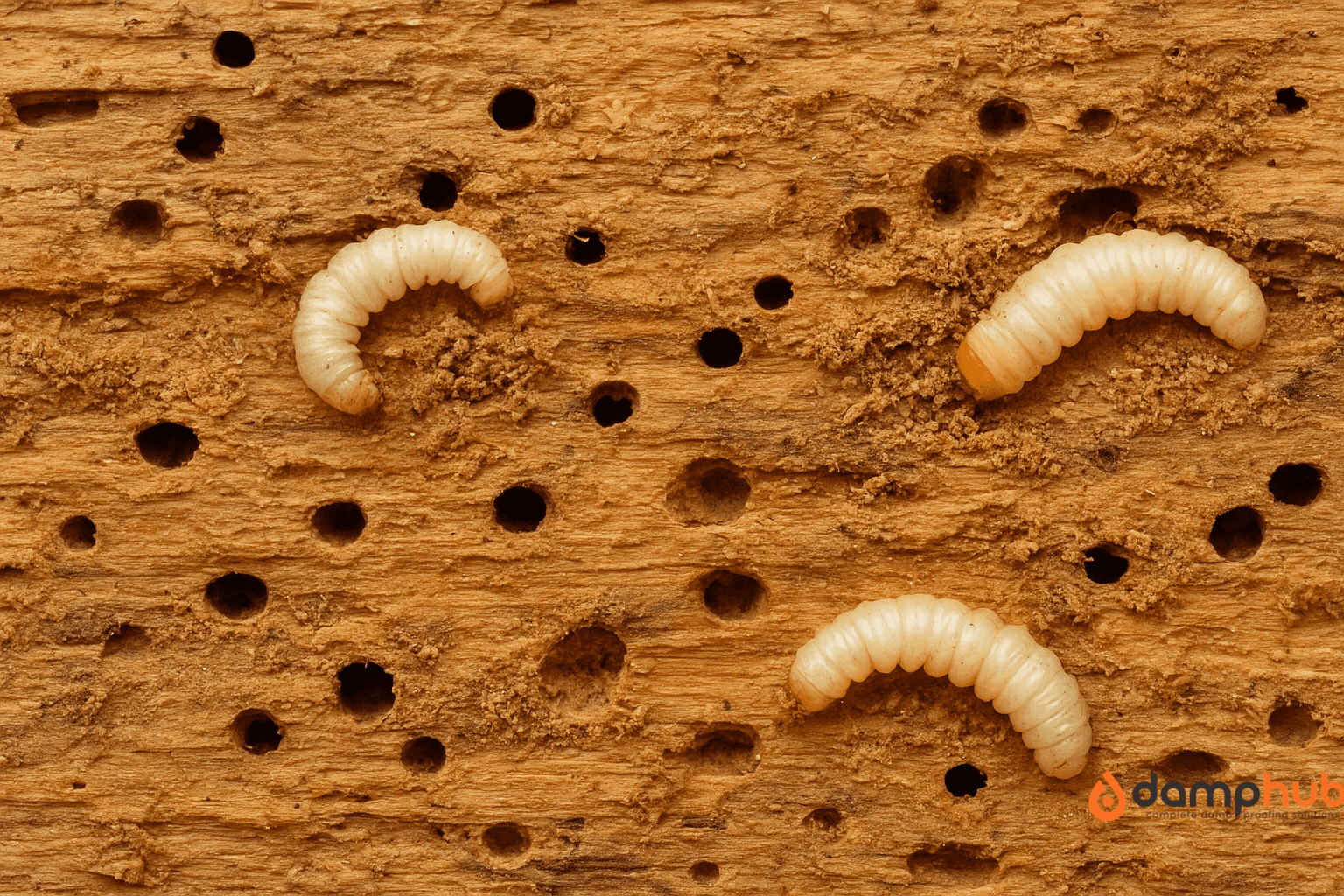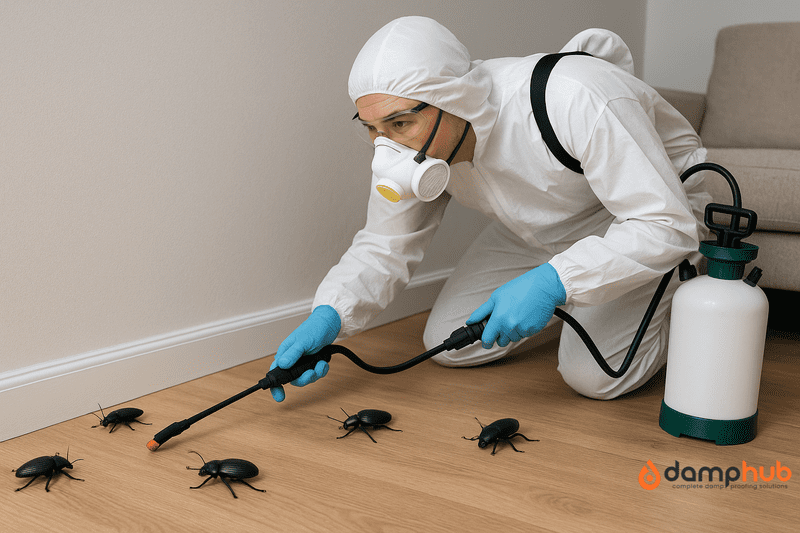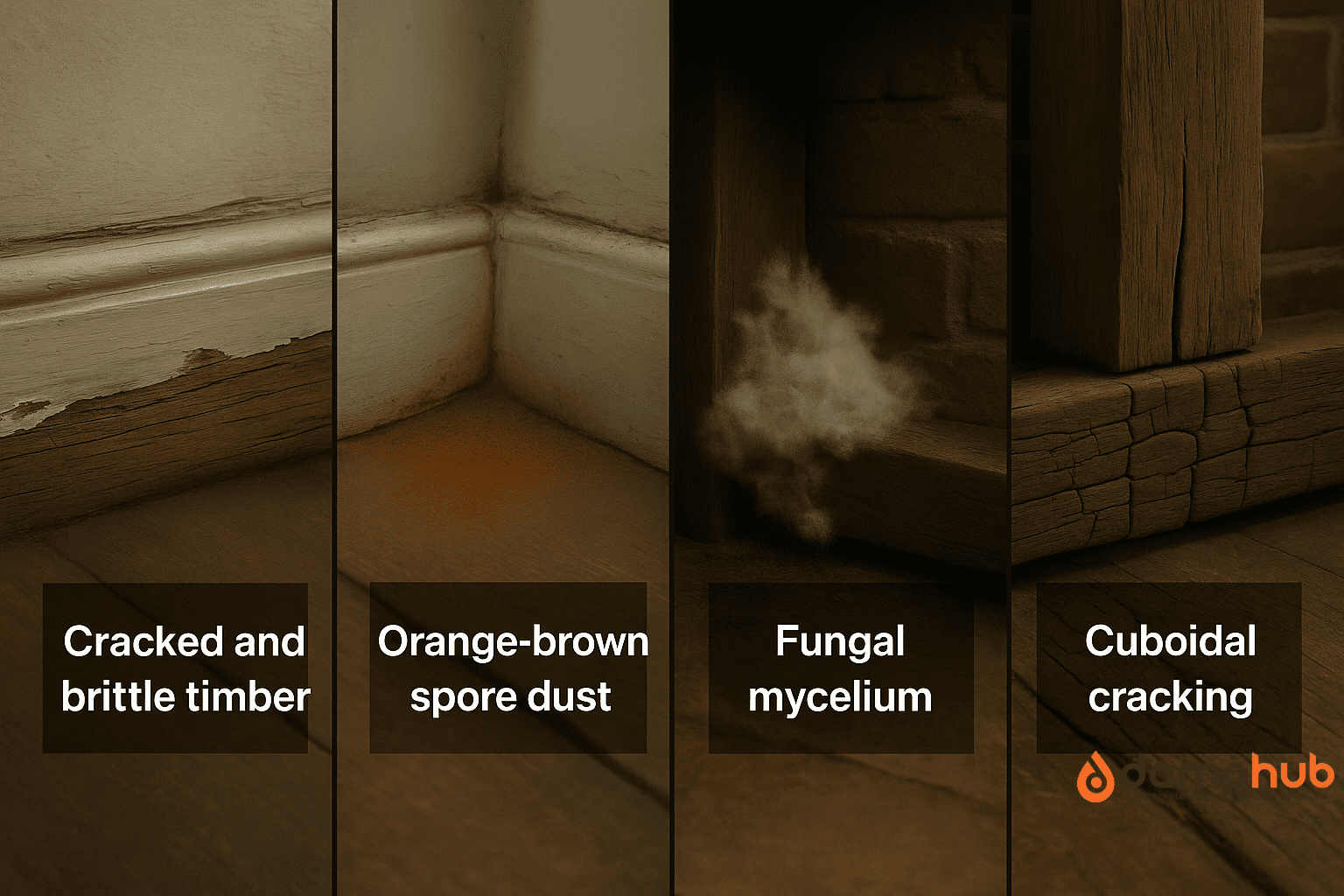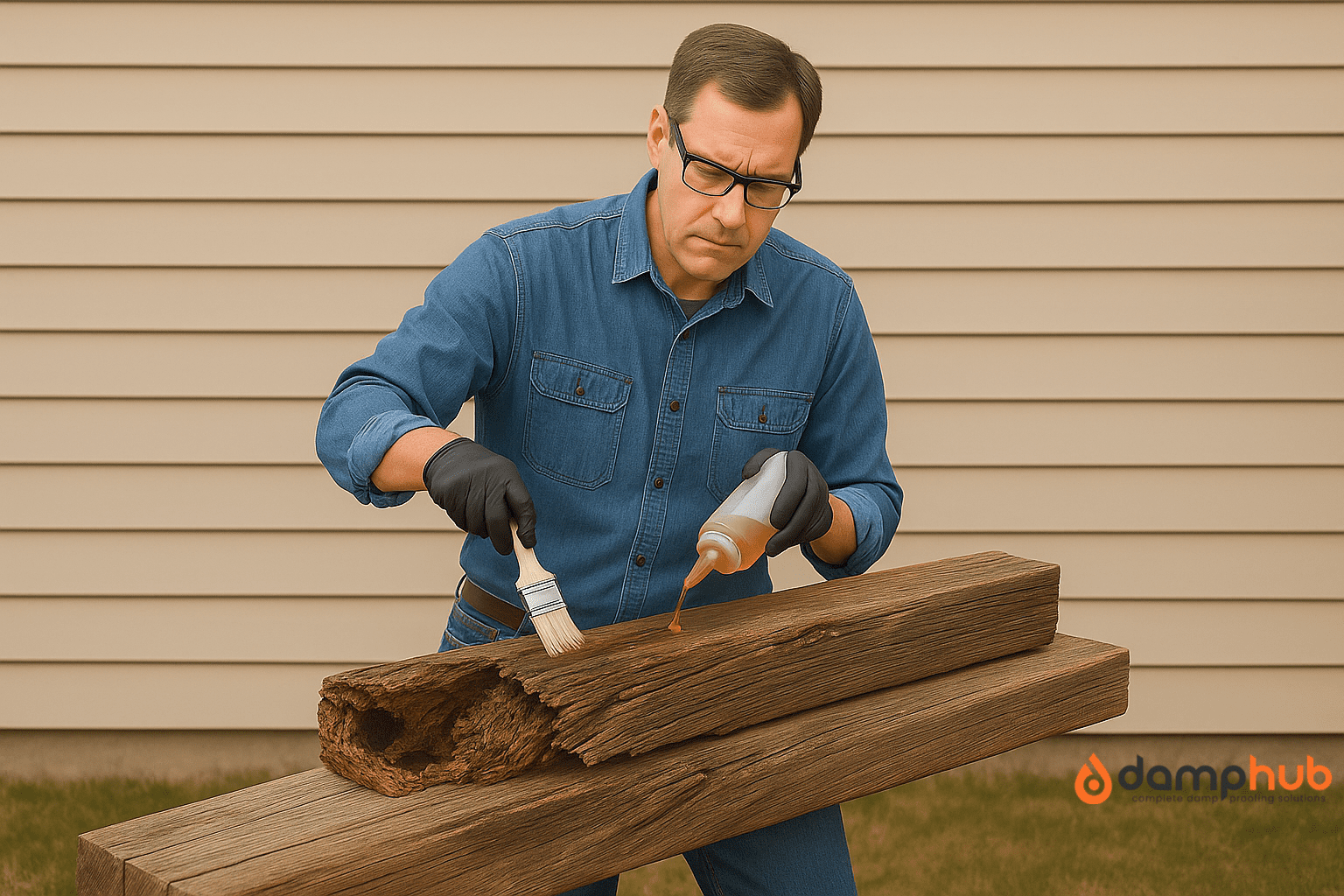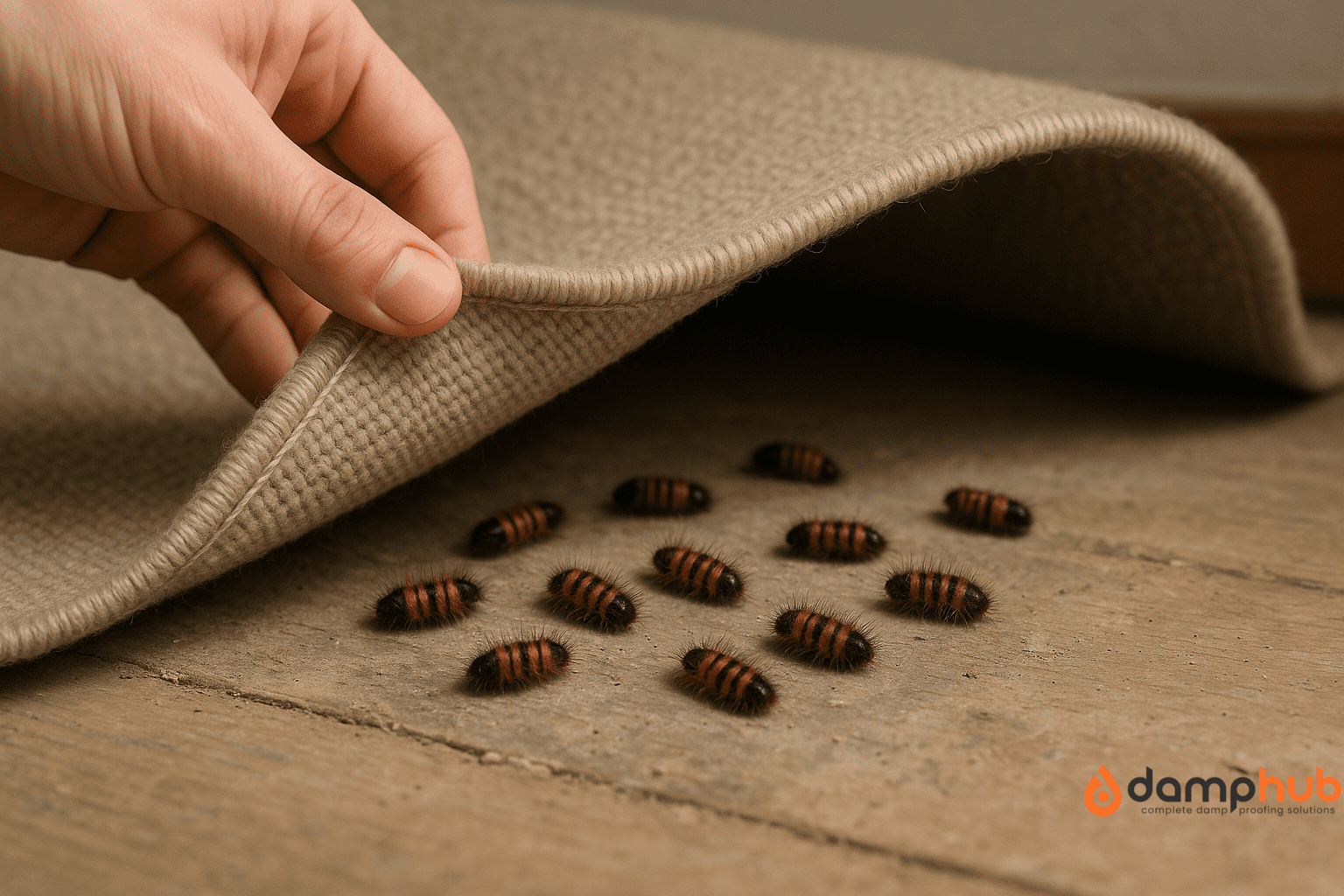
Quick Takeaways
- Woolly bear larvae are the real problem.
- Shed skins = clear warning signs.
- They hide in dark, undisturbed spots.
- Deep cleaning is the only real fix.
- Prevention is easier than treatment.
What is woolly bear carpet beetle? They are larvae of the varied carpet beetles.
You might think you don’t know them, but as a UK resident, you have probably encountered their signs — only that you didn’t recognise them.
If you have seen gritty dust that doesn’t look like ordinary dirt, shells stuck near baseboards, or holes in stored clothing, then woolly bear carpet beetles are already living rent-free in your home.
The best thing you can do now? Read this article to the end. We’ll tell you how to eliminate them to stop further damage, and how to prevent a recurrence or full-on invasion if you’re not a victim yet.
👉 Must Read: How to Identify and Get Rid of Black Carpet Beetle
What Is Woolly Bear Carpet Beetle?
We have just said the woolly bear is the larval stage of the varied carpet beetle, but you need to know more.
Young and unnoticeable as the larvae are, they are the ones that do all the eating, hiding, and destroying in silence.
Beetle larvae feed on items like wool and leather because they’re rich in keratin, a natural protein the larvae need to grow.
These materials mimic what they’d eat in the wild, like animal hair or skin. Indoors, your clothes and furnishings become the next best thing.
In short, it’s a small, hairy crawler that chews through natural fibres — wool, silk, feathers, leather, and fur. It’s not cuddly. It’s not slow. And it doesn’t stop unless you make it.
What Does Woolly Bear Carpet Beetle Look Like?
- Size: 4–5 mm long
- Colour: Brown or striped, often with alternating bands
- Shape: Like a hairy pill — cigar-shaped with bristles
- Texture: Covered in stiff hairs, some hooked at the ends
- Movement: Slow, deliberate crawl. No scuttling.
Tip:
Spot tiny husks that look like dust or lint near skirting boards or corners? Those are shed skins—clear signs larvae have been feeding for a while.
Where Do Woolly Bear Carpet Beetles Come From?
The adult beetle usually flies in through open windows, especially during spring and early summer. It’s harmless at that point, feeding on pollen/nectar and drawn to light.
But soon it starts laying eggs inside your home, preferably in quiet, dark corners near natural fibres, and that’s when the real damage begins.
The eggs hatch into larvae in those hidden spots, and they get straight to feeding. If you don’t notice them on time, they can stick around for up to a year, quietly growing and doing damage the whole time.
👉 Must Read: What Is a Varied Carpet Beetle?
Where Do Woolly Bear Carpet Beetles Hide?
These aren’t surface pests. They prefer areas that rarely get touched — places you probably haven’t cleaned in months or those you almost neglected.
Top hiding spots include:
- Under the edges of wool rugs
- Inside wardrobes and folded winter clothes
- Behind skirting boards or radiators
- In floor vents or heating ducts
- Deep inside old furniture
- At the back of the drawers you never open
- Inside loft spaces and storage boxes
What Damage Do Woolly Bear Carpet Beetles Do?
Some warning signs that you may be dealing with woolly bear carpet beetles include:
- You find your stored clothes with holes. Usually irregular holes.
- Fibres missing from your rug
- Fluff gathering strangely near a baseboard.
- Soft furnishings showing strange signs of wear
Eventually, the pattern forms. And when it does, you’ve already got a problem.
Unlike moths that leave neat, punched holes, woolly bears chew ragged, uneven damage. They fray the fibres. The clothes look like they’re unravelling. The damage isn’t just visible — you can feel the thinning.
And there’s more. The hairs on these larvae can irritate and even cause allergic reactions. Some vulnerable people report mild rashes, itchiness, and even breathing issues in heavy beetle infestations. If you feel itchy after sorting through old clothes, this could be why.
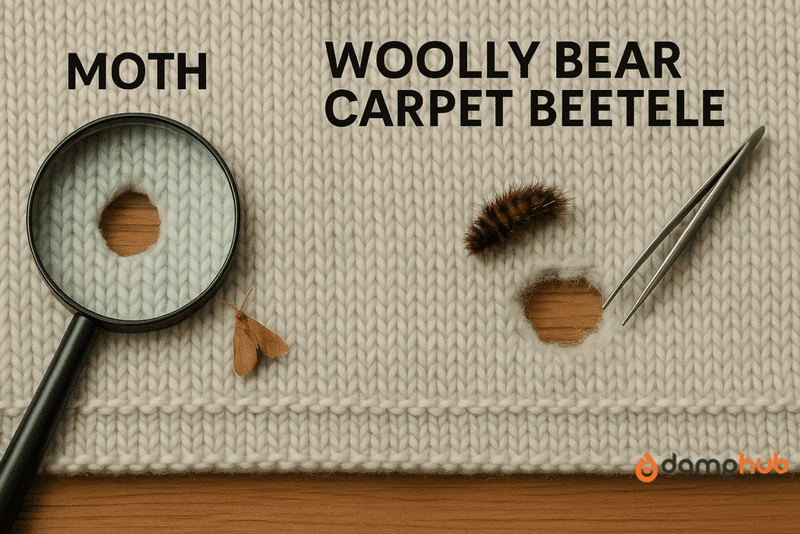
How Long Do Woolly Bear Carpet Beetle Live?
Woolly bear larvae are in no hurry.
- Larval stage: Up to 12 months (longer in colder rooms)
- Pupal stage: A few weeks
- Adult beetle: Lives 2–6 weeks, just enough time to mate and lay eggs
That means they can quietly feed behind your sofa for a year before you notice. And unless you interrupt the cycle, it just keeps going — from egg to beetle to more eggs, over and over.
👉 Must Read: How to Treat Carpet Beetle Rash
Are Woolly Bear Carpet Beetles Dangerous to People?
They don’t bite. They don’t sting. They’re not poisonous.
But they can still cause problems:
- Allergic skin reactions
- Itchy eyes or sneezing if their hair becomes airborne
- Anxiety from the damage to irreplaceable items
They’re classed as textile pests, not health hazards. But if you’ve ever pulled out a ruined winter coat or found your stored baby clothes full of holes, you’ll know — the stress is real.
How Do You Know You Have Woolly Bear Carpet Beetles?
Actually you will hardly notice. What will warn you is the damage you’ll regret.
Don’t wait for that moment. Here’s what to look for early:
- Brown shells or skin casings — dry, small, and flaky
- Dusty grit in drawers or on carpets — looks like pepper or crushed biscuit
- Tiny holes or thinning patches in wool clothes or rugs
- Adult beetles near windows or on curtains — often mistaken for tiny ladybirds
- Larvae crawling under rugs or in storage boxes
If you spot more than one of these signs, act fast. You’ve got more than a visitor. You’ve got tenants.
How Do You Get Rid of Woolly Bears?
Start with a deep clean — and that doesn’t mean a once-over with the vacuum. You’ll need to go all in.
1. Give the Carpets a Good Hoover
- Under rugs
- Skirting board edges
- Inside wardrobes, drawers, vents
- Behind furniture
- Inside sofa cushions
Tip:
Empty the vacuum immediately, outside, sealed in a bag. Otherwise, you just move the problem from one room to another.
2. Hot Wash or Freeze Affected Items
- Wash anything washable (pillowcases, scarves, socks, and anything else larvae might cling to) at 60°C or higher
- Anything delicate? Bag it and freeze for at least 72 hours
3. Use Insecticide (If Needed)
Only if cleaning alone isn’t enough.
Look for products with:
- Permethrin
- Cyfluthrin
- Insect Growth Regulators (IGRs)
Spray into crevices, carpet edges, and inside furniture joints. Always follow the label. And ventilate well.
4. Repeat
Cleaning once won’t do it.
- Vacuum daily for 10–14 days
- Repeat sprays after a week
- Keep checking for signs
If you stop too soon, the cycle continues. They’re slow, but persistent.
Can You Prevent a Woolly Bear Carpet Beetle Infestation?
Yes — and it’s far easier than dealing with one.
- Vacuum regularly, including under beds and furniture
- Don’t store dirty clothes — even body oils on “clean” clothes attract them
- Seal seasonal clothing in airtight bags or plastic boxes
- Check second-hand items before bringing them inside
- Use cedarwood blocks or lavender sachets in drawers — they deter adult beetles
- Keep window screens shut in summer to block beetles from flying in
Good to Know:
It’s all about making your home less comfortable for them to settle. If there’s nothing to eat and nowhere to hide, they’ll go elsewhere.
See Also👉: How to Get Rid of Carpet Beetles in the UK

When Should You Call Pest Control?
If you’ve done all the above and you’re still finding:
- Fresh larvae
- New holes
- More skins and gritty frass
…then it’s time to bring in a pest specialist.
In the UK, most pest control companies will charge between £150 and £300, depending on the size of your home and the treatment type. It’s not cheap, but it’s often far cheaper than replacing damaged carpets, upholstery, or sentimental textiles.
Final Thought: What Is Woolly Bear Carpet Beetle?
Woolly bears aren’t aggressive. They won’t crawl over your face at night or bite your pets. But they will slowly destroy things you care about — coats, rugs, blankets, baby clothes, cushions. And they’ll do it from behind the scenes.
So don’t wait. If you’ve seen the dust, the shells, the wear, start cleaning. Get ahead of it. And if you haven’t seen them yet? Stay ready.
Because these pests don’t knock when they move in. They just get to work.
Quick Recaps
- Look for gritty dust and larval husks.
- Holes in woollens mean active feeding.
- Vacuuming alone isn’t enough.
- Freeze or hot wash all affected items.
- Seal clothes and block entry points.
Answering Your Questions on What Is Woolly Bear Carpet Beetle

-
How do they treat for carpet beetles?
Professional treatments usually combine insecticidal sprays, insect growth regulators (IGRs), and deep cleaning.
A pest control technician will focus on larval hiding spots, such as under carpets, in vents, and along skirting boards.
In severe cases, they may use fogging or heat treatments to reach hidden larvae and eggs.
-
How to permanently get rid of carpet beetle?
There’s no instant fix — you need a thorough routine:
– Vacuum edges, under furniture, and soft furnishings regularly.
– Wash infested clothes and fabrics at 60°C or freeze them.
– Seal clean items in airtight containers.
– Treat with residual insecticides or diatomaceous earth where needed.
– Repeat over several weeks — and don’t skip deep corners. -
How does carpet beetle spray work?
Most sprays kill on contact or leave a residual coating that larvae crawl through. Some contain IGRs that stop eggs and larvae from developing.
They’re useful — but only after a deep clean. Sprays alone won’t work if you skip vacuuming or miss hidden nests.
-
What month are carpet beetles most active?
Carpet beetles are most active in the UK spring and summer, especially May to August. That’s when adults mate and lay eggs, and when larvae begin feeding.
You’ll often spot them near windows or light sources during this period.
-
Does vacuuming every day get rid of carpet beetles?
Daily vacuuming can help control them — but won’t get rid of them completely unless you’re hitting the right spots. Focus on:
-Skirting boards
-Under rugs and beds
-Inside drawers and wardrobes
-Combine vacuuming with washing, sealing, and treatment for best results. -
Where do carpet beetles lay eggs?
Carpet beetles lay eggs in dark, undisturbed areas where larvae will have food. That includes:
-Inside wardrobes and drawers
-Under carpets and rugs
-Around air vents and insulation
-In stored fabrics, pet bedding, or old furniture
-They avoid high-traffic or frequently cleaned areas. -
Why are they called carpet beetles?
They earned the name because their larvae feed on carpets, especially older types made from wool or mixed fibres.
Modern synthetic carpets aren’t as appealing, but carpet beetles still target rugs, upholstery, clothes, and stored fabrics made from natural materials.
-
What to do if you find a woolly bear?
A “woolly bear” is the larva of a carpet beetle — and it’s a red flag.
Don’t touch it with your bare hands — it can cause skin irritation.
Vacuum the area thoroughly and dispose of the bag outdoors.
Inspect nearby fabrics for signs of damage or more larvae.
Follow with a hot wash or freeze treatment for affected items.


